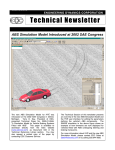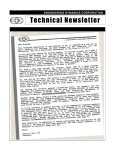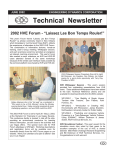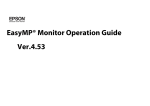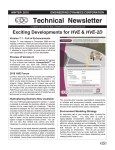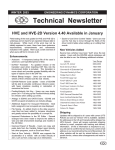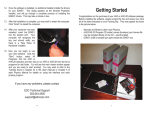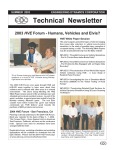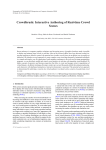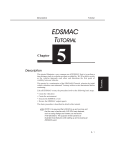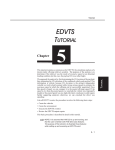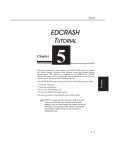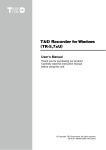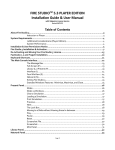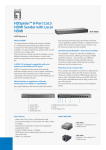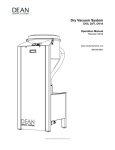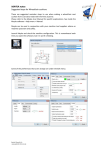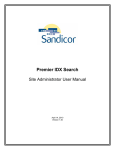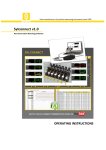Download Winter 2008 - Engineering Dynamics Corporation
Transcript
WINTER 2008 ENGINEERING DYNAMICS CORPORATION Technical Newsletter Available on-line in the EDC website Library at www.edccorp.com HVE & HVE-2D Version 6.00 Available Soon HVE and HVE-2D Version 6.00 are in the final stage of development and will be available soon. Here is a brief overview of some of the enhancements users will find in Version 6.00: DyMESH Version 2.0 DyMESH has been significantly improved in the following areas: _ Multi-vehicle Collision Simulation _ Vehicle vs. Environment - Rollover Simulation _ Contact Algorithm and Deformation _ Force and Acceleration vs. Time History _ Restitution Modeling Early testing also shows event run times of validation cases have been reduced by as much as 40 percent. More details about the improvements to DyMESH are presented in the Technical Session of this newsletter. Advanced Mesh Options Dialog DyMESH users will now be able to optimize their simulation runs using the Advanced Mesh Options dialog. In this dialog, the user drags an adjustable cylinder to select the region of the vehicle mesh requiring detailed tessellation. These actions reduce calculation run times and also improve results for pole impact collisions or other simulations where highly detailed vehicle meshes are required. Close up view of EDSMAC4 Calculation Options dialog showing the new Steer Degree of Freedom (DOF) options and also the new Inter-Vehicle Connection options. AutoConnect Tow and Towed Vehicles EDSMAC4, EDVTS and EDVDS now provide an option for automatic matching of the connection heights between tow and towed vehicles. The user can choose between settings of Manual (User-Adjusted), Adjust Tow Vehicle, Adjust Trailer or Adjust Both Equally using the Calculation Options dialog for the event. EDSMAC4 Steer Degree of Freedom EDSMAC4 now supports the Steer Degree of Freedom The Inter-Process Communication (IPC) has been further redesigned to utilize shared memory for communication between HVE and all HVE-compatible physics programs. This redesign eliminates the use of sockets, thereby avoiding any conflicts with firewall settings or other Internet security programs. Model as discussed in the Technical Session of the Summer 2007 Newsletter. A great application of this feature is in the situation where a vehicle is spinning and/or sliding after a collision, and the driver is disabled and not providing steering input. In this situation, the vehicle is essentially self-steering based upon its steering system geometry and the current (post-impact) slip angle at each tire. The Steer DOF Model can simulate the post-collision steer angle history, providing an obvious improvement in the crash reconstruction. Vehicle Mesh Tessellation in EDSMAC EDSMAC4 Damage Reporting users will now have the option to apply tessellation to the mesh of a generic vehicle which will improve the visualization of the damage profiles of vehicles involved in collision simulations. matching the CDC, PDOF, Delta-V and Peak Acceleration to a Damage Range. These results are presented in the Damage Data report in Playback. IPC Redesign EDSMAC EDSMAC4 now has improved post processor logic for Technical Newsletter WINTER 2008 Technical Session This Technical Session provides a high-level overview of the changes incorporated into DyMESH. We have gained much experience with DyMESH since its introduction in March 2004. We had invested years (literally) to develop a 3-D collision simulation code that was stable and robust. And though we were largely successful, while evaluating hundreds of events supplied by DyMESH users, we found conditions where DyMESH needed improvement. As a result of nearly a year of redevelopment, we are releasing DyMESH Version 2. The first thing you will notice is that the DyMESH dialog (see Figure 1) has been greatly simplified. The simplification has been the result of two things. First, several of the original DyMESH options related to the contact algorithm were made available in the dialog simply because we did not have the experience to know which options might be helpful to our users. After several years, we now have that experience. Unnecessary options have been removed. Figure 1 - New, simplified DyMESH Options dialog Figure 2 - DyMESH simulation of a hypothetical 4-car collision, simulating simultaneous collision forces between four vehicles. Key Results windows show collision force on each vehicle. 2 WINTER 2008 Technical Newsletter Second, the new contact algorithm (see discussion below) removes the need for many of the original options. The technical enhancements to following areas: DyMESH fall into the Ø Multi-vehicles Simulation Ø Vehicle vs. Environment Simulation Ø Super-tessellation Ø Contact Algorithm and Deformation Ø Force (and Acceleration) vs. Time History Ø Restitution Each of these areas is addressed below. Multi-vehicle Collision Simulation Although many users discovered that DyMESH appeared to work for events involving three (or more) vehicles, EDC had not performed a rigorous investigation and did not officially endorse its use for such applications. Part of the development of DyMESH Version 2 involved a thorough investigation of the code as it applies to multi-vehicle simulation. Limitations were found (complicated issues involving the number of vertices on each vehicle mesh and the order of collisions) and removed. DyMESH Version 2 supports multi-vehicle simulation. Figure 2 shows a four-vehicle simulation involving simultaneous contact between all four vehicles. This condition is handled by the new code. Vehicle vs. Environment Simulation DyMESH Version 1 did not simulate collision forces between a vehicle and the environment. This precluded its use for rollover simulation. Some users got around this restriction by placing a vehicle with an environment-emulating mesh into the ground. This is no longer required. DyMESH Version 2 includes direct interaction between vehicle(s) and the environment surface. This enhancement allows for direct simulation of rollover crashes, wherein the vehicle body interacts Figure 3 - DyMESH simulation of a hypothetical rollover showing vehicle body vs. environment interaction. Key Results window shows impact forces and moments. 3 Technical Newsletter WINTER 2008 with the ground. Collisions between vehicles and rigid barriers, such as bridge abutments and other fixed objects, may also be simulated directly. Figure 3 shows a rollover collision simulation. Figure 4 shows a simulation between a vehicle and a highway overpass support. However, when an entire vehicle is tessellated to 2 inches, the number of vertices reaches an astronomical value (say a half a million!). Simulation time and computer memory requirements make such a simulation totally impractical, thus pole simulations were not done. Simulating rollovers using SIMON/DyMESH provides another important improvement in rollover simulation. The issue of an excessive wheel force launching the vehicle during a rollover (this is caused when the tire plane becomes nearly parallel to the road plane and the tire radius calculation yields an abnormally large tire deflection) can be eliminated. Simply use SIMONs Radial Spring Tire-terrain Model option. DyMESH Super-tessellation Contact Algorithm and Deformation narrow object impact (e.g., a telephone pole or a tree) was not previously practical. Although DyMESH would theoretically work, the vehicle mesh in the vicinity of impact needed to be tessellated using a very small dimension, say 2 to 3 inches. Technically speaking, the most important internal change to DyMESH has been a significant revision of the contact algorithm. The contact algorithm is the part of DyMESH that determines how much, and in what direction, the mesh moves on one vehicle during impact DyMESH simulation of Version 2 takes advantage of HVEs Advanced Mesh Options dialog which allows the user to select a small section of the vehicle mesh and tessellate it to a very small size without changing the remainder of the mesh. Thus, it is now possible to choose a 2 inch tessellation just in the vicinity of impact on the mesh. Pole impacts are now quick and easy, as shown in Figure 4. Figure 4 - DyMESH simulation of a 35 mph collision involving a van and a highway overpass support. Peak acceleration was 39 g. 4 WINTER 2008 with another vehicle (or environment). We had seen conditions where the mesh deformed significantly on one vehicle while there was not as much deformation as we would expect on the other vehicle (of similar stiffness). Our research showed this was occurring because one vehicles mesh became concave-shaped. The source of the condition was traced to the fact that in DyMESH Version 1, only the slave vehicle vertices deform during a single timestep. The contact algorithm was changed to deform vertices on both the master and slave vehicle simultaneously. As a result, crush depth is also simulated more accurately. Another significant improvement is that DyMESH Version 2 does not require that the mesh be water-tight. This reduces the burden on the mesh builder, especially for environment meshes (a back side is not required). The radio button on the Vehicle Mesh dialog (Water-tight: Yes/No/Dont Know) has thus been removed as it is no longer required. Force (and Acceleration) vs. Time History The new contact algorithm has solved several problems. For example, depending on which vehicle was the slave vehicle, the calculated force, which is based on the vertex displacement of the slave vehicle, is predicted more accurately. This has an obvious effect on acceleration as well. Thus, the overall collision dynamics are improved. Restitution DyMESH uses the Relaxation Length value (default = 0.10, or 10 percent) in the Vehicle Mesh dialog to determine how much vertex displacement is restored during contact. A value of 0 means that there is no vertex restoration and thus no restitution force. The mesh concavity issue described earlier (see Contact Algorithm and Deformation) prevented restitution from working properly. The result was essentially zero restitution. The new contact algorithm results in the expected restitution behavior. These improvements and additional information about the theory and application of DyMESH will be discussed in great detail in the DyMESH 3-D Collision Model workshop at the 2008 HVE Forum. Technical Newsletter Using the Buttons on the Right Side of the Viewer The buttons down the right side of the viewer can help HVE and HVE-2D users work efficiently in their reconstructions or simulations. Heres a brief description of each button: Select/Pick Button Selects Object Pick mode. The cursor shape will change to an arrow. In this mode, the user is selecting objects or icons (e.g. vehicles, wheels, library objects) displayed in the viewer. Manipulate View Button Selects Manipulate mode. The cursor shape will change to a hand icon. In this mode, the user is moving the camera in space. Help This menu provides help about the viewer. Home Button Returns the camera to its home position (initial position if not set using the Set Home button). Set Home Button Resets the home position to the current camera position. View All Button Brings the entire scene into view. (Be careful! In the Environment and Event Modes, the entire scene includes the light source used for the sun position which is a long, long way away from the environment model.) Seek Button Allows the user to select a new center of rotation for the camera. When clicked in Manipulate mode, the cursor changes to a crosshair. The next left mouse click selects the object underneath the cursor as the new center of rotation. When the button is released, the camera moves to its new position. Projection Button Selects the type of camera used by the viewer. It toggles between the two available camera types perspective (a view of a three dimensional image that portrays height, width, and depth) and orthographic (a projection on a plane, using lines perpendicular to the plane). 5 Technical Newsletter 2008 HVE Forum February 18 - 22, 2008 San Diego, CA Join your colleagues at the 2008 HVE Forum and learn how to Hang Ten using your HVE or HVE-2D software. The 2008 HVE Forum offers workshops of interest to every user of HVE and HVE-2D. For example, you might choose to study the background, theory and application for your physics programs. Or you might choose to learn how to build a vehicle from scratch, build a 3-dimensional scene using survey data, run test simulations to adjust vehicle parameters and then work through real-world cases using a variety of analytical approaches and techniques. At the 2008 HVE Forum, you have choices from a large selection of workshops, the HVE White Paper session, Users Groups and interactive social hours for everyone. As in previous years, the Advanced HVE workshops are filling up quickly with users eager to learn a tremendous amount of detailed information about how to apply their software to real-world crash analyses. 6 WINTER 2008 Workshop schedules, descriptions, registration forms and details about the hotel and special room rates are available to download on the 2008 HVE Forum pages of the website. Visit www.edccorp.com or call EDC Customer Service at 503.644.4500 and sign up today! About the 2008 HVE Forum Hotel The Holiday Inn San Diego - On The Bay offers a convenient hotel location and San Diego waterfront destination. Just a complimentary shuttle ride from San Diego International Airport and footsteps to the Downtown Gaslamp Quarter. This San Diego lodging is popular for its proximity to fine restaurants, theaters, museums, shops, and sporting venues. A special room rate of $165.00 per night has been arranged for your stay during the 2008 HVE Forum. To receive this special rate, you must use the Group Booking Code HVE when making your reservation. This special rate will only be available until January 18, 2008, or while rooms are available in the block. February is a very popular time of year for visiting San Diego, so dont wait until the last minute to make your reservations if you want to stay at the 2008 HVE Forum hotel! WINTER 2008 Recommendations for Windows Vista Installations If you are not the sole Administrative User on a computer using any version of Windows Vista, we strongly recommend that you install HVE or HVE-2D into a location other than the default Program Files folder that has been used for Windows XP installations. One of Vistas security features could make it very difficult to locate the case files and simulation movie files you create while using HVE. Heres a description of the security feature and how it affects users: Vista strongly protects the Program Files folder against unauthorized writing or creating of files. The user of an application that needs to write into any folder within the Program Files location must have administrative privileges for the program to function as expected. However, Vista will allow a user without administrative privileges to run the application using a feature called File and Registry Virtualization. This feature redirects the writes and subsequent reads to a user virtual store located within the users profile. This feature tricks the application into thinking they are still running with full administrative privileges, but simply redirects the reads and writes elsewhere. For example, in HVE, the case files are usually placed in C:\Program Files\HVE\supportFiles\case. If the user does not have administrative privileges, then HVE will not write to this folder, and the write will get redirected to C:\Users\username\AppData\Local\ VirtualStore\ProgramFiles\HVE\supportFiles\case, with the username being the currently logged on user ID. However, in HVE, all file browsers will appear to be looking in C:\Program Files\HVE\supportFiles\case, but when outside of HVE, a file browser will not show your new files in that location. Users can look for the new files in the VirtualStore directory, which is hidden by default. To make your file browser find these redirected files, simply press the Compatibility Files button on Windows Explorer or any Explorer Shell Window. Note that the Compatibility Files button will only appear when there is a virtual version of a file related to the current directory. Once pressed, the user will be taken to the virtual store location to view all redirected files. Note: This column has been summarized from an article on the My Digital Life website at www.mydigitallife.info. Readers are encouraged to visit their website for more information. Technical Newsletter HVE and HVE-2D F.A.Q. This section contains answers to frequently asked questions submitted to EDC Technical Support staff by HVE and HVE-2D users. Q: I have a case that requires a commercial vehicle that is not available in the EDVDB vehicle database. How can I create my own vehicle? A: You can start with the appropriate class of generic vehicle (for more details see EDC Publication 19 Updating the Vehicle Class Categories in the Technical Reference Library on the EDC website) and then edit the data parameters to match the specifics for your vehicle. You may be able to determine values from physical measurements or from the manufacturer of your case vehicle. That procedure will take care of the data required for the appropriate behavior of the vehicle in your reconstruction or simulations. If you also require a geometry file (3-D model) of the vehicle, one option is to build your own model using a total station or photogrammetry program to take measurements of the actual vehicle, then use a CAD program to build a surfaced 3-D model of the vehicle in DXF or VRML format. Another option may be to find and edit an existing model available from Internet sites like www.digimation.com, www.3dcadbrowser.com or www.turbosquid.com. More details about the process of how EDC builds complete vehicles (data and geometry) for the EDVDB vehicle database and also how to build your own vehicles are available in the Building a Vehicle for HVE & HVE-2D workshop at the 2008 HVE Forum. Q. Whats the easiest way to use an aerial photograph or scaled drawing image as an environment for my reconstructions or simulations? A. Build a scaled surface in the 3-D Editor and then apply the image as a Material Texture. Follow the steps in your Users Manual section for the 3-D Editor for exact details. Another option is to join www.DiscoverHVE.com and use their PhotoIntoHVE utility program to create the surface and apply your image. In just a few minutes you will have an environment model thats ready to drive on. Visit the Support section of www.edccorp.com for the latest Downloads and answers to F.A.Q.’s. 7 Technical Newsletter EDC Training Courses EDC Reconstruction & EDC Simulations EDC offers an excellent training course on the use of the EDC reconstruction program, EDCRASH. Both new and long-time users of EDCRASH agree that the EDC Reconstruction course is extremely beneficial and challenging. EDC also offers an excellent training course on the use of EDC simulation programs, such as EDSMAC, EDSMAC4, EDSVS and EDVTS. The EDC Simulations course offers the fastest way to learn what you really need to know how to efficiently use the program and get the right results. These one-week courses are designed to fully investigate the programs inner workings. Lectures are full of helpful hints gained from years of experience. During the course, students will use the programs (e.g. EDCRASH, EDSMAC4) in either the HVE or HVE-2D simulation environment to complete several workshops highlighting the capabilities of the programs. HVE Forum The HVE Forum is an excellent opportunity for HVE and HVE-2D users to jump to a new level of ability. By participating in workshops, attendees brush up on their present skills, learn new techniques, and learn how to use the latest advancements in the software. The HVE Forum also presents a great opportunity to meet other users and expand your network of resources. Engineering Dynamics Corporation Training Course Schedule EDC Simulations Los Angeles, CA . . . . . . . . . . January 2009 Miami, FL . . . . . . . . . . . . . . November 2009 EDC Reconstruction Los Angeles, CA . . . . . . . . . . January 7 - 11, 2008 Miami, FL . . . . . . . .. . . . . November 10 - 14, 2008 Theoretical & Applied Vehicle Dynamics TBD. . . . . . . . . . . . .. . . . . . . . . . . . . . . . . TBA 2008 2008 HVE FORUM San Diego, CA . . . . . . . . . February 18 - 22, 2008 8 WINTER 2008 Vehicle Dynamics Theoretical and Applied Vehicle Dynamics extends the theory of the basic SAE course and includes direct applications using several vehicle simulation programs (e.g. SIMON, EDVSM) within the HVE simulation environment, as well as a solid theoretical background for such simulations. The course is focused towards vehicle design engineers and safety researchers with an interest in a greater understanding of vehicle dynamics and automotive chassis systems development. Hands-on Training Intensive hands-on training on how to use your HVE or system software, physics programs and databases is available. Contact EDC Customer Service for more information about bringing this two-day on-site course to your office. HVE-2D Course Registration You may register for a course by contacting EDC Customer Service at 503.644.4500, or by email to [email protected]. You can also visit the Training pages on our website and download a course registration form. All courses are eligible for Continuing Education Units and ACTAR credits. See you at our next course! Related Training Courses Northwestern University Center for Public Safety (NUCPS) is no longer actively scheduling the COMPTAR and MATAR courses which used EDCRASH and EDSMAC. The material previously covered in these courses is covered in the EDC Reconstruction and EDC Simulations courses. If you are interested in hosting one of these courses at your location, please contact EDC Customer Service at 503.644.4500. Engineering Dynamics Corporation 8625 SW Cascade Blvd, Suite 200 Beaverton, Oregon 97008 USA Phone 503.644.4500 / FAX 503.526.0905 Email: [email protected] Website: www.edccorp.com EDVAP, EDCRASH, EDSMAC, EDSMAC4, EDCAD, EDSVS, EDVTS, EDHIS, EDVSM, EDVDS, EDGEN, EDVDB, HVE, HVE-2D, HVE Brake Designer and GetSurfaceInfo() are trademarks of Engineering Dynamics Corporation. All Rights Reserved. SIMON and DyMESH (Patent number 6,195,625) are registered trademarks of Engineering Dynamics Corporation. All Rights Reserved. GATB, GBF, DiscoverHVE.com and PhotoIntoHVE are trademarks of Collision Engineering Associates, Inc.








